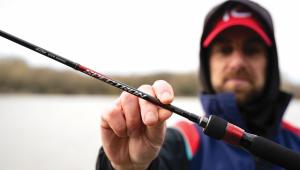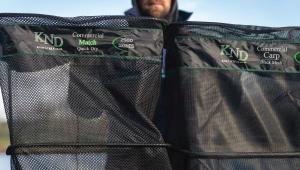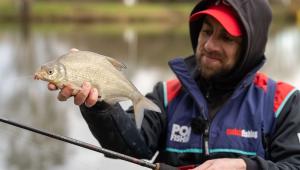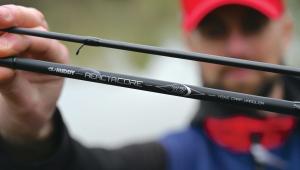Be A Crafty Carp Catcher… With Des Shipp!
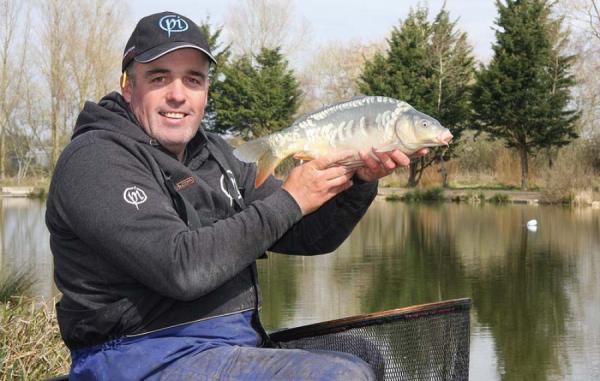
Modern-day commercials are full of fish, but in match conditions, it can be anything but easy to catch them as soon as those nets go in. Des Shipp explains how to maximise your results.
Such is the angling pressure on modern waters, particularly the more heavily fished ones, that the stocks seem to have wised up to sloppy approaches and mundane feeding tactics.
That’s not to say that these fish can’t be caught. Some days they give themselves up far easier, but when the weather conditions are cooler, or overnight temperatures drop, they can be anything but ‘easy’.
I’ve brought the Match Fishing cameras to Ivy House Lakes today, in Wiltshire. It’s a place I have some knowledge of, having fished here a little. One of the recent matches was tough going, but a thoughtful approach to tactics and feeding kept me in touch with the fish on what could have otherwise been a very bleak day – no pun intended.
Many on the match struggled, such were the conditions, so I kept things lighter on the rig front in anticipation of a tougher match.
Having drawn in a corner on the day I thought a long margin line, slightly into the deeper water down the shelf, would be key. It proved to be, so that’s the area I’ll concentrate on explaining in most depth for this feature.
I fed several lines on the day, as I have also done today; the other main one of note being an open-water swim straight in front of me at 14.5 metres.
The rig for this is made using a 0.4g Preston PB Inter 2 on 0.13mm Reflo Power to a 0.11mm hooklength. A strung bulk completes the rig along with a size 16 Preston PR 434.
The rig for fishing towards the margin, in around three and a half feet of water, is a 4x14 Preston PB Inter 8 mounted on the same line and using the same hook. The shotting pattern is taken care of with strung-out No10s to allow a slow fall of the expander pellet hook bait. It’s all about lifting and dropping the relatively light rig and allowing the hook bait to ‘work’ for you as naturally as possible.
Feeding
Now, this is the key area to success really. I have plumbed two lines across to the right-hand margin, one at 14.5 metres and one at 16 metres, but both the same distance away from the bank so I can use the same rig in two swims.
What I found on the match was that the fish were hanging off the back of the feed. So, I only pot bait in at 14.5 metres and intend to fish on that line to catch ‘mug’ fish, but fish past it at 16 metres when they back off.
Loose feeding is a key part of the strategy, with the aim being to loose feed bait over and just past the 14.5m line. That way I can always work the rig on the 16m line, which will be at the far extreme of the feed area where the ‘crafty’ carp hold back and venture onto the edge of the feed.
These fish have become wise to piles of bait and, as such, hang back with caution. Therefore a few pellets ‘flirted’ over the area with a rig offering a slow fall of the hook bait is THE key way to approach them.
The open-water swim is a key go-to area while you build the margin line as it’s important not to exploit the margin until fish, hopefully, carp, have built in confidence feeding there.
Bites on the margin line are often delicate too, hence I dot my float right down to maximise the rig sensitivity.

Des targeted the skimmers while he built up the margin line.
The open-water line on today’s session proves important for catching the resident skimmers – something that’s crucial on trickier days to help you to keep putting weight in the net while you build your other lines.
I want to briefly cover why I have not put my margin rigs right up against the bank in the shallowest water. This is simply because the fish aren’t wanting to feed there confidently at the time of shooting this feature, so coming away into three feet or so where the water is deeper is a more logical place. Don’t always assume these fish want to be right up in the ‘rat holes’. On many days you will reap better rewards by targeting them where I am today. Plus, it’s all too easy to get distracted by waving tails when you’re fishing in very shallow water – you won’t have this problem in three feet. This also has a knock-on with your feeding: when you can’t see the fish it’s less easy to get carried away with piling too much feed in and destroying your swims.

Des potted in pellets...
After two hours of nurture and with half a dozen good skimmers in the net it’s time for a look up the long margin swims. I have been potting modest amounts of bait on the 14.5m line, consisting of micro pellets and softened expander pellets (the same as I will be using on the hook).

... and pinged a few over the top.
I have regularly been loose feeding softened 4mm pellets over the top too, in frugal quantities to create some noise and keep that all-important bait going through the water column.
My swim-building is rewarded by a small but perfectly formed carp, but the next drop-in reveals no bites, liners or indications. Now the extension goes up the back of my Preston M90 pole to get the rig to the far extremes of the feed area at 16 metres.
The light proves tricky and the reflection on the water from the still bare surrounding trees is doing little to help.

The same rig was used at 14.5 and 16 metres.
The approach is a success, though. The float dips sharply and wham, another carp is stripping my 11H elastic from the pole as it makes its getaway.
Working the swim in this way is exactly the right thing to do. Now it’s a case of try and repeat.
By that I mean try the 14.5m line again and if no bites occur then I pot a modest amount of feed in (see image) and continue to loose feed just six to 10 softened 4mm feed pellets over the top between the 14.5m and 16m lines without feeding past where the rig will be when presented at 16 metres.
This approach has helped me to secure many a match win either in trickier conditions, or when fishing heavily pressured fish, or both.

Small but perfectly formed
I’ve ended the session with several carp and a handsome net of fine skimmers. These skimmers are so important to build weight elsewhere (usually in open water) while you nurture other swims. I haven’t truly exploited these silvers today as the nature of the shoot was to demonstrate the margin approach first and foremost. However, with my considered approach, you will be conquering crafty commercial-water carp in no time!
Like what you see?
Or buy a single issue
- Log in or register to post comments


